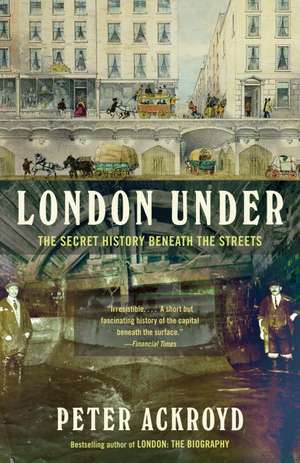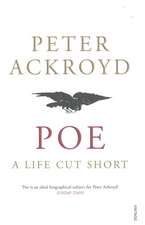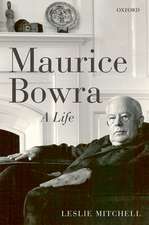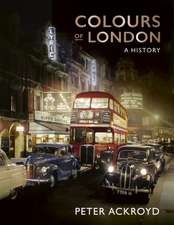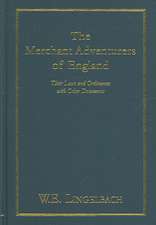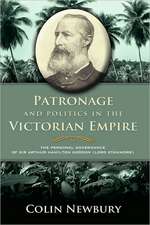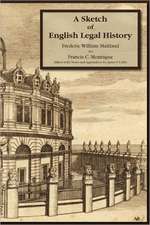London Under: The Secret History Beneath the Streets
Autor Peter Ackroyden Limba Engleză Paperback – 12 noi 2012
There is a Bronze Age trackway below the Isle of Dogs, Anglo-Saxon graves rest under St. Pauls, and the monastery of Whitefriars lies beneath Fleet Street. To go under London is to penetrate history, and Ackroyd's book is filled with the stories unique to this underworld: the hydraulic device used to lower bodies into the catacombs in Kensal Green cemetery; the door in the plinth of the statue of Boadicea on Westminster Bridge that leads to a huge tunnel packed with cables for gas, water, and telephone; the sulphurous fumes on the Underground's Metropolitan Line. Highly imaginative and delightfully entertaining, London Under is Ackroyd at his best.
Preț: 91.10 lei
Nou
Puncte Express: 137
Preț estimativ în valută:
17.44€ • 17.97$ • 14.64£
17.44€ • 17.97$ • 14.64£
Carte indisponibilă temporar
Doresc să fiu notificat când acest titlu va fi disponibil:
Se trimite...
Preluare comenzi: 021 569.72.76
Specificații
ISBN-13: 9780307473783
ISBN-10: 0307473783
Pagini: 228
Ilustrații: 44 ILUSTRATION
Dimensiuni: 135 x 203 x 17 mm
Greutate: 0.25 kg
Editura: Anchor Books
ISBN-10: 0307473783
Pagini: 228
Ilustrații: 44 ILUSTRATION
Dimensiuni: 135 x 203 x 17 mm
Greutate: 0.25 kg
Editura: Anchor Books
Notă biografică
PETER ACKROYD is the author of London: The Biography, Shakespeare: The Biography, Thames: The Biography, and Venice: Pure City; acclaimed biographies of T. S. Eliot, Dickens, Blake, and Sir Thomas More; and several successful novels. He has won the Whitbread Book Award for Biography, the James Tait Black Memorial Prize, and the Somerset Maugham Award, among others.
Extras
Chapter 1
1. DARKNESS VISIBLE
Tread carefully over the pavements of London for you are treading on skin, a skein of stone that covers rivers and labyrinths, tunnels and chambers, streams and caverns, pipes and cables, springs and passages, crypts and sewers, creeping things that will never see the light of day.
A vast concourse of people, buried deep within the clay of the Eocene period, move beneath your feet in underground trains. Rooms and corridors have been created for the settlement of thousands of people in the event of calamity. You are also treading on the city of the past, all of its history from the prehistoric settlers to the present day packed within 24 feet of earthen fabric. The past is beneath us. It exists still as the companion of the present city. It is crowded. It has its own heat. A hundred feet beneath the ground the temperature hovers at 19° Celsius or 65° Fahrenheit. It was once a little cooler, but the heat of the electric trains has quickened it. The clay surrounding the tunnels has absorbed the warmth.
In a previous book I have explored the city above the surface; now I wish to descend and explore its depths, which are no less bewildering and no less exhilarating. Like the nerves within the human body, the underworld controls the life of the surface. Our activities are governed and sustained by materials and signals that emanate from beneath the ground; a pulse, an ebb, a flow, a signal, a light, or a run of water, will affect us. It is a shadow or replica of the city; like London itself it has developed organically with its own laws of growth and change. It was said of the Victorian Londoner, wrapped in fog and darkness, that he or she would not know the difference between the two worlds. The underworld is haphazard and wayward, with many abandoned passages and vast tunnels of brick leading nowhere. Beneath Piccadilly Circus is another great circus of myriad ways. The roads that converge on the Angel, Islington, have their counterparts beneath the surface.
It is an unknown world. It is not mapped in its entirety. It cannot be seen clearly or as a whole. There are maps of gas facilities, of telecommunications, of cables and of sewers; but they are not available for public perusal. The dangers of sabotage are considered to be too great. So the underworld is doubly unknowable. It is a sequestered and forbidden zone. It must be said, too, that there is little interest in this vast underworld. To fear is added indifference. What is not seen is not respected. The majority of pedestrians do not know or care that vast caverns exist beneath their feet; as long as they can see the sky, they are content.
Yet there may be monsters. The lower depths have been the object of superstition and of legend as long as there have been men and women to wonder. The minotaur, half man and half bull, lived in a labyrinth buried beneath the palace at Knossos in Crete. A dog with three heads, Cerberus, guarded the gates of the underworld in classical myth. The Egyptian god of the underworld, Anubis, was a man with the head of a jackal. The journey under ground prompted strange transformations. Anubis was also known as "the lord of the sacred land," with the world beneath the ground creating a spiritual as much as a material presence. The great writers of antiquity-Plato and Homer, Pliny and Herodotus-have described the underground worlds as places of dream and hallucination. Most of the great religions have created temples and shrines beneath the surface of the earth. Terror lingers in caverns and caves, where there may be subterranean rivers and fires. Sixteen thousand years ago the wandering people of Europe lived in or beside the entrances to caves; but they painted frescoes in the deeper and darker spaces of the caverns. The further downward you travel, the closer you come to the power.
Good and evil can be found side by side; enchantment and terror mingle. If the underworld can be understood as a place of fear and of danger, it can also be regarded as a place of safety. A subterranean space may be the object of attraction as well as of fear. Healing wells and places of worship lie beneath the streets. Like a mother, the lower deep may have a warm embrace. It is a haven from the outside world. It is a refuge from attack. In the darkness you cannot be seen. In the world wars of the last century it became a shelter for many thousands of people. The catacombs of Rome protected the early Christians. We can repeat the words of Mr. Mole to Mr. Badger from The Wind in the Willows (1908): "Once well underground, you know exactly where you are. Nothing can happen to you, and nothing can get at you." "That's exactly what I say," Mr. Badger replies. "There's no security, or peace and tranquillity, except underground." There has always been a London world beneath London. The author of Unknown London (1919), Walter George Bell, remarked that "I have climbed down more ladders to explore the buried town than I have toiled up City staircases." There is more below than there is above. It is stated in one London guidebook, "certain it is that none who knows London would deny that its treasures must be sought in its depths."
Yet malefactors of the past were also consigned beneath the surface. The medieval prison, or compter, was essentially a hole or pit in the ground. The deeper the prisoner was taken in the Tower of London, the more vile the durance. One of the least desirable places in London is the underground prison beside Clerkenwell Green known as the House of Detention. It consists of a dank and cold series of tunnels, with small cells and other rooms ranged alongside them; the structure is cruciform in shape, and was once the basement of a larger building. Much of its brickwork dates from the late eighteenth century, and it is imbued with generations of suffering. Its arches, leading to covered chambers, are of the same date. It was used as a gaol for more than 250 years, and did not finally close until 1877. It is believed by many people to be malignant and is popularly supposed to be haunted. It is appropriate, perhaps, that the shades of the dead should still wander beneath the earth. The river Styx, moving underground between the living and the dead, still flows.
The subterranean world can be a place of fantasy, therefore, where the ordinary conditions of living are turned upside down. In the nineteenth century it was seen as a sanctuary for criminals, for smugglers, and for what were known as "night wanderers"; the cellars and tunnels beneath the ground were described as "hidden haunts of vice" populated by "the wild tribes of London" or the "City Arabs." They were supposed to harbour a criminal "underworld" that emerged only at night. According to John Hollingshead, the author of Underground London (1862), the tunnels were "black and dangerous labyrinths for the innocent stranger."
But the underworld can also become a place of romance, where the childhood impulse to hide can be indulged to the wildest extent. The idea of secret passages, of mysterious entrances and exits, of retreat and concealment, possesses an incurable charm. Yet if we are not found, in the game of hide-and-seek, what then? What if we were left alone in the darkness, our companions gone into the light?
Underground chambers and tunnels have been formed, and found, over the centuries. There are extensive catacombs in Camden Town, beneath Camden Market, and prehistoric tunnels are to be found under Greenwich Park. A German traveller of the eighteenth century noted that "one third of the inhabitants of London live under ground"; by which he meant that the poor dwelled in the curious basements or "cellar dwellings" that were once so common in the city. They were entered by steps leading down from the street to a well "which was supposed to be closed at nightfall by a flap." The poor were thus consigned to the lowest level. The vagrants of London often lived under bridges and under arches, replicating the conditions beneath the ground.
The Adelphi arches, just south of the Strand, once offered a glimpse of an old underworld. The Adelphi itself was built in the 1770s upon a series of vaults and arches that were described as "a reminder of the Etruscan cloaca of old Rome." In the nineteenth century these became a haven for criminals and beggars. It was reported in the public prints that assassins were concealed "in the dark arches," such as those that make up Lower Robert Street, exploiting the passageways, tunnels, precipitous steps, sudden turnings and high- arched doorways. Horses did not like to venture through them. Stalactites hung from their roofs. Cows were stabled there, and passed their lives in darkness.
Lower Robert Street is still forbidding; it is one of the few underground streets in London, and of course has the reputation of being haunted by a murdered prostitute. In his Picturesque Sketches of London (1852) Thomas Miller described the region of shadows lying between the Strand and the Thames with "the black-browed arches that span right and left, before and behind, covering many a rood of ground on which the rain never beats, nor the sunbeams sleep, and at the entrance of which the wind only seems to howl and whine, as if afraid of venturing further into the darkness." They were another reminder of the London depths.
The geology of London is a clue to the labyrinth beneath. The city sits upon a bed of sand, gravel, clay and chalk that make up the London Basin. Deep beneath them are the rocks of the Palaeozoic period shaped hundreds of millions of years before; no one has reached them yet. Above them lie levels of ancient materials that are known as Gault clay and upper greensand. In turn they support broad bands of chalk laid down when the site of London lay below a vast sea. Upon the chalk rests the clay. London clay is thick, viscous, and malleable; it is a greenish blue colour, but in its upper reaches it is reddish brown. It was formed more than fifty million years ago. This is the material in which the underworld of London sits. It is the material through which the tunnels of the underground railway are burrowed. The clay is compressed so heavily that all of its moisture has fled; but if the pressure is lifted it will expand and, in the words of the geologist, "come on." We may interpret this as "come forth."
Above the clay is a mixture of sand and gravel from which the springs of London rise; elevators and escalator-shafts lower passengers through this sandy medium. The glaciers of the Ice Age formed the rivers that still flow beneath the surface, and descend from the upper levels of the London region into the Thames. We inhabit an inconceivably ancient space. London is based upon clay, while Manhattan is established upon layers of hard rock known as mica- schist. That accounts for the preponderance of skyscrapers in the latter city. But may it not also help to explain the manifest differences in behaviour and attitude between their citizens?
London is slowly sinking into its clay, while Manhattan seems to rise and rise into the empyrean. So we go down to the clay and the water, the old elemental things of London. They are the origin, and they may also be the ending. The deep groundwater of the city is rising, and 15,400,000 gallons must be pumped out each day to save the entire structure.
Certain creatures roam the underworld. Rats, and eels, and mice, and frogs, abound. The brown rat from Russia is the most abundant. The native black rat was in recent years supposed to exist in certain underground quarters, beneath Oxford Street and Canning Town, but it is now more likely to be extinct. Sigmund Freud described the rat as a "chthonic animal," an emblem of the uncanny rather than the horrid; it is a reminder of the darkness, of all that we fear. The underground can also be seen as a representation of the human unconscious, the formless and inchoate source of our instincts and desires. It preserves the "truth" of our identity.
It is hard to estimate the number of rats beneath the city, but urban legend that they exceed the human population can be discounted. Supersonic sound is sometimes used in the sewers, sending the vermin mad with panic so that they dash themselves against the walls. It is difficult to envisage the scene. They are in any case diminished by natural forces; if they cannot escape, they are drowned in heavy rainstorms. They are rivalled by the cockroaches that can live partly on human excrement. The oriental or common cockroach, Blatta orientalis, scuttles beneath the streets of central London. It lives and thrives in a horde. Reports also sometimes circulate of white crabs existing upon the walls of underground tunnels, but that may be fantastic rumour. There have even been descriptions of scorpions, an inch long and pale yellow, on the Central Line. White atrophied creatures are often known as cavernophiles.
Stray dogs, lured by the warmth and the chance of food, come into the depths. Pigeons hop on and off the trains at convenient stations. A form of mosquito, not otherwise known in England, breeds in the tunnels with a captive population upon which to feed. The species, known as Culex pipiens, entered the system in the early part of the twentieth century and has been expanding ever since. A magazine, BBC Worldlife, reported that "the insect has evolved so fast that the difference between the overground and underground forms is as great as if they had been separated for thousands of years." At a deep level beneath the earth the mosquitoes have returned to their primeval origins.
The underworld is the place to which our waste and excrement are consigned. For that reason public lavatories were once placed under the ground, to be reached by a flight of downward stairs. Those who worked underground-the miner or the "flusher" of sewers-were to be feared. They were contaminated. They were closer to the devil. Radical political groups, characteristically using terror and violence as their weapons, are still known as "underground" movements.
When a system of underground railways was first proposed in the middle of the nineteenth century, a popular preacher declared very seriously that "the forthcoming end of the world would be hastened by the construction of underground railways burrowing into the infernal regions and thereby disturbing the devil." When the trains did run beneath the surface, their noise was compared by one reporter to "the shrieking of ten thousand demons."
The dead are also buried beneath the ground. So the underworld is a place that induces grief. The spaces beneath the City churches were filled to bursting by the nineteenth century, and there are reports even from the medieval period of noxious vapours issuing from beneath the surface. The plague pits of London can be found from Aldgate to Walthamstow. These are the areas where, if you dig, you may “let the plague out.” This fear is not entirely misplaced; the bacteria of the bubonic plague have long since been eroded, but the spores of anthrax can survive for hundreds of years.
There is no darkness like the darkness under the ground. It is pitched past pitch of black. You cannot see your hand before your face. The darkness enters you, as if you do not exist any more. In nightmare, this is what happens to you after death. You are suspended in eternal night. But no night is as black as subterranean blackness. It takes away all instinct for motion, because there is nowhere to flee.
It can be a vision of hell itself. In all representations of supernatural justice, heaven is above and hell is below. The topography is as fixed as east and west for the rising and setting of the sun. Order and harmony are the properties of the lighted world. All below is shapeless, formless, void. Forgotten things, discarded things, secret things, are to be found deep below.
From the Hardcover edition.
1. DARKNESS VISIBLE
Tread carefully over the pavements of London for you are treading on skin, a skein of stone that covers rivers and labyrinths, tunnels and chambers, streams and caverns, pipes and cables, springs and passages, crypts and sewers, creeping things that will never see the light of day.
A vast concourse of people, buried deep within the clay of the Eocene period, move beneath your feet in underground trains. Rooms and corridors have been created for the settlement of thousands of people in the event of calamity. You are also treading on the city of the past, all of its history from the prehistoric settlers to the present day packed within 24 feet of earthen fabric. The past is beneath us. It exists still as the companion of the present city. It is crowded. It has its own heat. A hundred feet beneath the ground the temperature hovers at 19° Celsius or 65° Fahrenheit. It was once a little cooler, but the heat of the electric trains has quickened it. The clay surrounding the tunnels has absorbed the warmth.
In a previous book I have explored the city above the surface; now I wish to descend and explore its depths, which are no less bewildering and no less exhilarating. Like the nerves within the human body, the underworld controls the life of the surface. Our activities are governed and sustained by materials and signals that emanate from beneath the ground; a pulse, an ebb, a flow, a signal, a light, or a run of water, will affect us. It is a shadow or replica of the city; like London itself it has developed organically with its own laws of growth and change. It was said of the Victorian Londoner, wrapped in fog and darkness, that he or she would not know the difference between the two worlds. The underworld is haphazard and wayward, with many abandoned passages and vast tunnels of brick leading nowhere. Beneath Piccadilly Circus is another great circus of myriad ways. The roads that converge on the Angel, Islington, have their counterparts beneath the surface.
It is an unknown world. It is not mapped in its entirety. It cannot be seen clearly or as a whole. There are maps of gas facilities, of telecommunications, of cables and of sewers; but they are not available for public perusal. The dangers of sabotage are considered to be too great. So the underworld is doubly unknowable. It is a sequestered and forbidden zone. It must be said, too, that there is little interest in this vast underworld. To fear is added indifference. What is not seen is not respected. The majority of pedestrians do not know or care that vast caverns exist beneath their feet; as long as they can see the sky, they are content.
Yet there may be monsters. The lower depths have been the object of superstition and of legend as long as there have been men and women to wonder. The minotaur, half man and half bull, lived in a labyrinth buried beneath the palace at Knossos in Crete. A dog with three heads, Cerberus, guarded the gates of the underworld in classical myth. The Egyptian god of the underworld, Anubis, was a man with the head of a jackal. The journey under ground prompted strange transformations. Anubis was also known as "the lord of the sacred land," with the world beneath the ground creating a spiritual as much as a material presence. The great writers of antiquity-Plato and Homer, Pliny and Herodotus-have described the underground worlds as places of dream and hallucination. Most of the great religions have created temples and shrines beneath the surface of the earth. Terror lingers in caverns and caves, where there may be subterranean rivers and fires. Sixteen thousand years ago the wandering people of Europe lived in or beside the entrances to caves; but they painted frescoes in the deeper and darker spaces of the caverns. The further downward you travel, the closer you come to the power.
Good and evil can be found side by side; enchantment and terror mingle. If the underworld can be understood as a place of fear and of danger, it can also be regarded as a place of safety. A subterranean space may be the object of attraction as well as of fear. Healing wells and places of worship lie beneath the streets. Like a mother, the lower deep may have a warm embrace. It is a haven from the outside world. It is a refuge from attack. In the darkness you cannot be seen. In the world wars of the last century it became a shelter for many thousands of people. The catacombs of Rome protected the early Christians. We can repeat the words of Mr. Mole to Mr. Badger from The Wind in the Willows (1908): "Once well underground, you know exactly where you are. Nothing can happen to you, and nothing can get at you." "That's exactly what I say," Mr. Badger replies. "There's no security, or peace and tranquillity, except underground." There has always been a London world beneath London. The author of Unknown London (1919), Walter George Bell, remarked that "I have climbed down more ladders to explore the buried town than I have toiled up City staircases." There is more below than there is above. It is stated in one London guidebook, "certain it is that none who knows London would deny that its treasures must be sought in its depths."
Yet malefactors of the past were also consigned beneath the surface. The medieval prison, or compter, was essentially a hole or pit in the ground. The deeper the prisoner was taken in the Tower of London, the more vile the durance. One of the least desirable places in London is the underground prison beside Clerkenwell Green known as the House of Detention. It consists of a dank and cold series of tunnels, with small cells and other rooms ranged alongside them; the structure is cruciform in shape, and was once the basement of a larger building. Much of its brickwork dates from the late eighteenth century, and it is imbued with generations of suffering. Its arches, leading to covered chambers, are of the same date. It was used as a gaol for more than 250 years, and did not finally close until 1877. It is believed by many people to be malignant and is popularly supposed to be haunted. It is appropriate, perhaps, that the shades of the dead should still wander beneath the earth. The river Styx, moving underground between the living and the dead, still flows.
The subterranean world can be a place of fantasy, therefore, where the ordinary conditions of living are turned upside down. In the nineteenth century it was seen as a sanctuary for criminals, for smugglers, and for what were known as "night wanderers"; the cellars and tunnels beneath the ground were described as "hidden haunts of vice" populated by "the wild tribes of London" or the "City Arabs." They were supposed to harbour a criminal "underworld" that emerged only at night. According to John Hollingshead, the author of Underground London (1862), the tunnels were "black and dangerous labyrinths for the innocent stranger."
But the underworld can also become a place of romance, where the childhood impulse to hide can be indulged to the wildest extent. The idea of secret passages, of mysterious entrances and exits, of retreat and concealment, possesses an incurable charm. Yet if we are not found, in the game of hide-and-seek, what then? What if we were left alone in the darkness, our companions gone into the light?
Underground chambers and tunnels have been formed, and found, over the centuries. There are extensive catacombs in Camden Town, beneath Camden Market, and prehistoric tunnels are to be found under Greenwich Park. A German traveller of the eighteenth century noted that "one third of the inhabitants of London live under ground"; by which he meant that the poor dwelled in the curious basements or "cellar dwellings" that were once so common in the city. They were entered by steps leading down from the street to a well "which was supposed to be closed at nightfall by a flap." The poor were thus consigned to the lowest level. The vagrants of London often lived under bridges and under arches, replicating the conditions beneath the ground.
The Adelphi arches, just south of the Strand, once offered a glimpse of an old underworld. The Adelphi itself was built in the 1770s upon a series of vaults and arches that were described as "a reminder of the Etruscan cloaca of old Rome." In the nineteenth century these became a haven for criminals and beggars. It was reported in the public prints that assassins were concealed "in the dark arches," such as those that make up Lower Robert Street, exploiting the passageways, tunnels, precipitous steps, sudden turnings and high- arched doorways. Horses did not like to venture through them. Stalactites hung from their roofs. Cows were stabled there, and passed their lives in darkness.
Lower Robert Street is still forbidding; it is one of the few underground streets in London, and of course has the reputation of being haunted by a murdered prostitute. In his Picturesque Sketches of London (1852) Thomas Miller described the region of shadows lying between the Strand and the Thames with "the black-browed arches that span right and left, before and behind, covering many a rood of ground on which the rain never beats, nor the sunbeams sleep, and at the entrance of which the wind only seems to howl and whine, as if afraid of venturing further into the darkness." They were another reminder of the London depths.
The geology of London is a clue to the labyrinth beneath. The city sits upon a bed of sand, gravel, clay and chalk that make up the London Basin. Deep beneath them are the rocks of the Palaeozoic period shaped hundreds of millions of years before; no one has reached them yet. Above them lie levels of ancient materials that are known as Gault clay and upper greensand. In turn they support broad bands of chalk laid down when the site of London lay below a vast sea. Upon the chalk rests the clay. London clay is thick, viscous, and malleable; it is a greenish blue colour, but in its upper reaches it is reddish brown. It was formed more than fifty million years ago. This is the material in which the underworld of London sits. It is the material through which the tunnels of the underground railway are burrowed. The clay is compressed so heavily that all of its moisture has fled; but if the pressure is lifted it will expand and, in the words of the geologist, "come on." We may interpret this as "come forth."
Above the clay is a mixture of sand and gravel from which the springs of London rise; elevators and escalator-shafts lower passengers through this sandy medium. The glaciers of the Ice Age formed the rivers that still flow beneath the surface, and descend from the upper levels of the London region into the Thames. We inhabit an inconceivably ancient space. London is based upon clay, while Manhattan is established upon layers of hard rock known as mica- schist. That accounts for the preponderance of skyscrapers in the latter city. But may it not also help to explain the manifest differences in behaviour and attitude between their citizens?
London is slowly sinking into its clay, while Manhattan seems to rise and rise into the empyrean. So we go down to the clay and the water, the old elemental things of London. They are the origin, and they may also be the ending. The deep groundwater of the city is rising, and 15,400,000 gallons must be pumped out each day to save the entire structure.
Certain creatures roam the underworld. Rats, and eels, and mice, and frogs, abound. The brown rat from Russia is the most abundant. The native black rat was in recent years supposed to exist in certain underground quarters, beneath Oxford Street and Canning Town, but it is now more likely to be extinct. Sigmund Freud described the rat as a "chthonic animal," an emblem of the uncanny rather than the horrid; it is a reminder of the darkness, of all that we fear. The underground can also be seen as a representation of the human unconscious, the formless and inchoate source of our instincts and desires. It preserves the "truth" of our identity.
It is hard to estimate the number of rats beneath the city, but urban legend that they exceed the human population can be discounted. Supersonic sound is sometimes used in the sewers, sending the vermin mad with panic so that they dash themselves against the walls. It is difficult to envisage the scene. They are in any case diminished by natural forces; if they cannot escape, they are drowned in heavy rainstorms. They are rivalled by the cockroaches that can live partly on human excrement. The oriental or common cockroach, Blatta orientalis, scuttles beneath the streets of central London. It lives and thrives in a horde. Reports also sometimes circulate of white crabs existing upon the walls of underground tunnels, but that may be fantastic rumour. There have even been descriptions of scorpions, an inch long and pale yellow, on the Central Line. White atrophied creatures are often known as cavernophiles.
Stray dogs, lured by the warmth and the chance of food, come into the depths. Pigeons hop on and off the trains at convenient stations. A form of mosquito, not otherwise known in England, breeds in the tunnels with a captive population upon which to feed. The species, known as Culex pipiens, entered the system in the early part of the twentieth century and has been expanding ever since. A magazine, BBC Worldlife, reported that "the insect has evolved so fast that the difference between the overground and underground forms is as great as if they had been separated for thousands of years." At a deep level beneath the earth the mosquitoes have returned to their primeval origins.
The underworld is the place to which our waste and excrement are consigned. For that reason public lavatories were once placed under the ground, to be reached by a flight of downward stairs. Those who worked underground-the miner or the "flusher" of sewers-were to be feared. They were contaminated. They were closer to the devil. Radical political groups, characteristically using terror and violence as their weapons, are still known as "underground" movements.
When a system of underground railways was first proposed in the middle of the nineteenth century, a popular preacher declared very seriously that "the forthcoming end of the world would be hastened by the construction of underground railways burrowing into the infernal regions and thereby disturbing the devil." When the trains did run beneath the surface, their noise was compared by one reporter to "the shrieking of ten thousand demons."
The dead are also buried beneath the ground. So the underworld is a place that induces grief. The spaces beneath the City churches were filled to bursting by the nineteenth century, and there are reports even from the medieval period of noxious vapours issuing from beneath the surface. The plague pits of London can be found from Aldgate to Walthamstow. These are the areas where, if you dig, you may “let the plague out.” This fear is not entirely misplaced; the bacteria of the bubonic plague have long since been eroded, but the spores of anthrax can survive for hundreds of years.
There is no darkness like the darkness under the ground. It is pitched past pitch of black. You cannot see your hand before your face. The darkness enters you, as if you do not exist any more. In nightmare, this is what happens to you after death. You are suspended in eternal night. But no night is as black as subterranean blackness. It takes away all instinct for motion, because there is nowhere to flee.
It can be a vision of hell itself. In all representations of supernatural justice, heaven is above and hell is below. The topography is as fixed as east and west for the rising and setting of the sun. Order and harmony are the properties of the lighted world. All below is shapeless, formless, void. Forgotten things, discarded things, secret things, are to be found deep below.
From the Hardcover edition.
Recenzii
“Irresistible. . . . [A] short but fascinating history of the capital beneath the surface.” —The Financial Times
“Wondrous. . . . Ackroyd follows seemingly all the rivers, streams, pipes, sewers and tunnels that ever crisscrossed the city.” —The New York Times Book Review
“There is perhaps no other English writer today as dedicated a Londoner as Peter Ackroyd. . . . A memorable homage to [London].” —The San Francisco Chronicle
Beautiful. . . . Each chapter has a vital story full of intriguing detail. . . . Ackroyd writes with his usual enthusiastic flair, and entertains us with chthonic demons and treasures.” —The Columbus Dispatch
“Relentlessly interesting urban mythology, from unearthed Roman galleys to subterranean Cabinet War Rooms.” —New York Daily News
“Throughout the book, Ackroyd is not just interested in London’s hidden relics; he’s interested in what they—and the idea of an underground—mean to a culture. London’s underworld is a ‘shadow or replica of the city,’ and it is also a shadow of ourselves and our thoughts, the stuff that’s discovered when we open the trapdoor.” —The Daily Beast
“Anyone intrigued by this tumultuous city will devour London Under in a few transporting hours. . . . Packed with revelations. . . . Ackroyd's stylistic brilliance explains why the book remains a rattling good read.” —The Independent (London)
“For Peter Ackroyd, the subterranean world holds a potent allure. London Under, his brief account of the capital’s catacombs and other murky zones, manages to radiate a dark mystery and sulphur reek. . . . Fascinating. . . . Peter Ackroyd illuminates the shadow world within us all.” —The Spectator
“With quick, deft stitches he sews the fantastical and the familiar into a macabre sampler of the city that exists beneath the feet of its citizens.” —The Times (London)
“As ever his research is meticulous, his scope expansive, his writing definitive. Every sentence is delivered with judicial gravity and command. . . . Once again, Ackroyd shares his vision of a mythical city most do not see.” —Time Out
“For Peter Ackroyd, the subterranean world holds a potent allure. London Under, his brief account of the capital’s catacombs and other murky zones, manages to radiate a dark mystery and sulphur reek. . . . Fascinating. . . . Peter Ackroyd illuminates the shadow world within us all.” —The Spectator
“With quick, deft stitches he sews the fantastical and the familiar into a macabre sampler of the city that exists beneath the feet of its citizens.” —The Times (London)
“Wondrous. . . . Ackroyd follows seemingly all the rivers, streams, pipes, sewers and tunnels that ever crisscrossed the city.” —The New York Times Book Review
“There is perhaps no other English writer today as dedicated a Londoner as Peter Ackroyd. . . . A memorable homage to [London].” —The San Francisco Chronicle
Beautiful. . . . Each chapter has a vital story full of intriguing detail. . . . Ackroyd writes with his usual enthusiastic flair, and entertains us with chthonic demons and treasures.” —The Columbus Dispatch
“Relentlessly interesting urban mythology, from unearthed Roman galleys to subterranean Cabinet War Rooms.” —New York Daily News
“Throughout the book, Ackroyd is not just interested in London’s hidden relics; he’s interested in what they—and the idea of an underground—mean to a culture. London’s underworld is a ‘shadow or replica of the city,’ and it is also a shadow of ourselves and our thoughts, the stuff that’s discovered when we open the trapdoor.” —The Daily Beast
“Anyone intrigued by this tumultuous city will devour London Under in a few transporting hours. . . . Packed with revelations. . . . Ackroyd's stylistic brilliance explains why the book remains a rattling good read.” —The Independent (London)
“For Peter Ackroyd, the subterranean world holds a potent allure. London Under, his brief account of the capital’s catacombs and other murky zones, manages to radiate a dark mystery and sulphur reek. . . . Fascinating. . . . Peter Ackroyd illuminates the shadow world within us all.” —The Spectator
“With quick, deft stitches he sews the fantastical and the familiar into a macabre sampler of the city that exists beneath the feet of its citizens.” —The Times (London)
“As ever his research is meticulous, his scope expansive, his writing definitive. Every sentence is delivered with judicial gravity and command. . . . Once again, Ackroyd shares his vision of a mythical city most do not see.” —Time Out
“For Peter Ackroyd, the subterranean world holds a potent allure. London Under, his brief account of the capital’s catacombs and other murky zones, manages to radiate a dark mystery and sulphur reek. . . . Fascinating. . . . Peter Ackroyd illuminates the shadow world within us all.” —The Spectator
“With quick, deft stitches he sews the fantastical and the familiar into a macabre sampler of the city that exists beneath the feet of its citizens.” —The Times (London)
Descriere
Descriere de la o altă ediție sau format:
London Under is an atmospheric, imaginative introduction to everything that goes on under London, from original springs and streams and Roman amphitheatres to Victorian sewers, gang hideouts and modern Underground stations.
London Under is an atmospheric, imaginative introduction to everything that goes on under London, from original springs and streams and Roman amphitheatres to Victorian sewers, gang hideouts and modern Underground stations.
